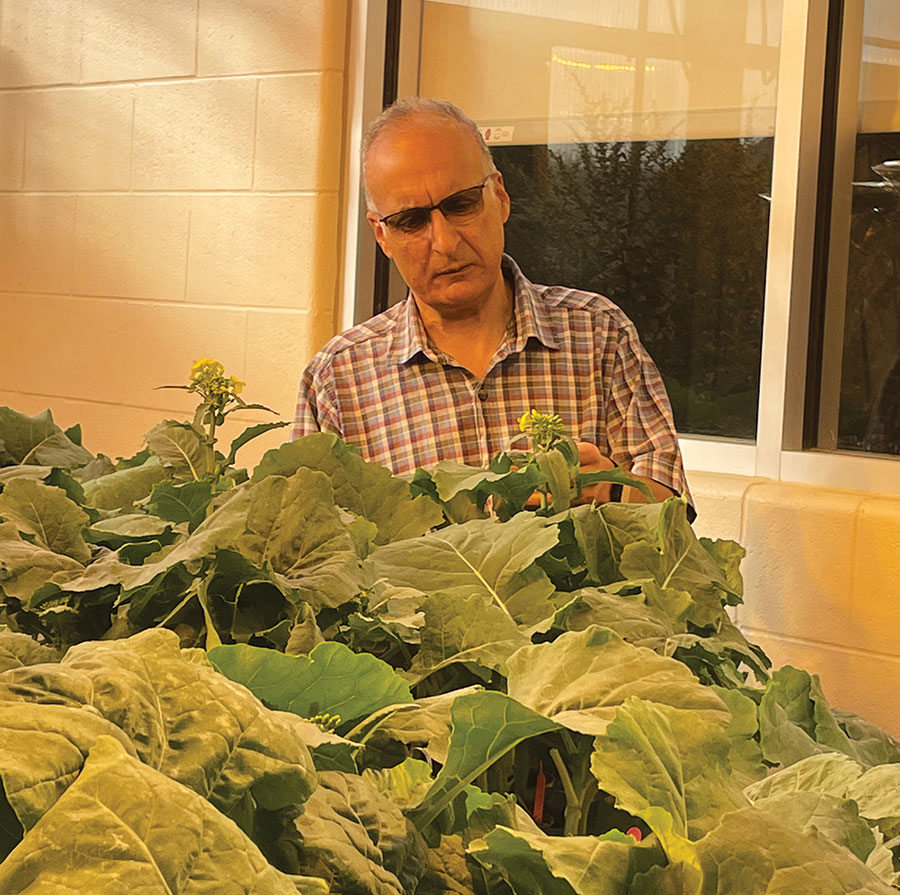A new gene for blackleg resistance
Key result:
AAFC researchers completed the genetic mapping of blackleg resistance gene Rlm11. Rlm11 is effective against L. maculans isolates carrying the avirulence gene AvrLm11, which is found in 95 per cent of L. maculans isolates collected from Western Canadian canola farms. Canola lines with Rlm11 will enable canola farmers to effectively control the blackleg disease.
Project title, principal investigator:
“Introgression of the highly effective Brassica rapa blackleg resistance gene Rlm11 into spring-type Brassica napus” Hossein Borhan,
AAFC Saskatoon
Funding:
SaskCanola, Saskatchewan’s Agriculture Development Fund, Western Grains Research Foundation
Full report:
To find the full report, go to SaskCanola’s research page at saskcanola.com/research-results and search for the project title.

Genetic resistance is the most cost-effective, efficient and environmentally safe approach for protecting crops such as canola against various pathogens, particularly for blackleg fungus L. maculans that does not respond to late applied – after cotyledon or early true leaves – foliar fungicides. To date, 19 resistance (R) genes in Brassica have been identified (named as Rlm or LepR) that confer resistance to various isolates of L. maculans with matching avirulence (Avr) genes.
However, tight crop rotations and the rapid emergence of new virulent isolates of L. maculans have led to resistance breakdown, forcing researchers to search for new sources of R genes. Field surveys across Western Canadian canola farms found that blackleg races with the avirulence (Avr) gene AvrLm11 were highly prevalent at greater than 95 per cent of fields across the Prairies. This makes the matching R gene, Rlm11, a highly relevant and effective gene used in canola cultivars in Western Canada. Rlm11 was identified in a Brassica rapa accession; however, the genome location of the gene and associated markers were unknown, and incorporation of Rlm11 from B. rapa is challenging and time-consuming for canola breeders.
Researchers with Agriculture and Agri-Food Canada (AAFC) have recently addressed these issues in a four-year project initiated in 2016. Objectives were to complete the genetic mapping of the blackleg resistance gene Rlm11, to incorporate Rlm11 from the winter-type B. rapa to a spring-type B. napus and to generate molecular markers linked to Rlm11.
Researchers first identified a B. rapa line that contained the race-specific resistance gene Rlm11. This homozygous Rlm11 line named BR-11 was used to generate inter-species (B. napus x B. rapa) mapping populations by crossing BR-11 to the double haploid, blackleg susceptible B. napus line Topas DH16516. DNA from 96 F2 lines was applied to the Brassica 60K Illumina single nucleotide polymorphism (SNP) genotyping marker array and a genome scale SNP map was generated. Rlm11 was found to be positioned on the lower arm of chromosome A07 in a region between the previously mapped Rlm1 and the Rlm3-4-7-9 gene cluster.
To generate the spring type B. napus Rlm11 introgression lines, the B. napus susceptible line Topas DH16516 was chosen as the recipient parent. Several resistant individuals were selected for successive backcrossing to the susceptible Topas DH16516 parental line. Plants with a normal spring-type growth habit and good seed set were selected at each back-cross generation. Researchers advanced the generation of Topas-Rlm11 introgression lines through further back-crossing to produce and phenotype advanced back-cross populations. These advanced populations were screened to generate and identify further recombination in the Rlm11 region. In the fall of 2021, advanced generations of Topas-Rlm11 introgression lines were harvested. These lines will be used to produce bulk seeds for distribution among canola breeders and agronomists.
As a result of the project, researchers have completed the genetic mapping of the blackleg resistance gene Rlm11 and successfully developed Topas-Rlm11 introgression lines. Researchers also generated molecular markers linked to Rlm11. These markers will be shared with the industry and canola breeders. Rlm11 markers and Topas-Rlm11 introgression lines will allow canola breeders to offer a new and effective resistance gene to farmers. Canola cultivars with Rlm11 combined with the blackleg race determination markers developed in this project will enable canola farmers to continue to effectively control blackleg disease in the future when new varieties incorporate Rlm11 resistance.





